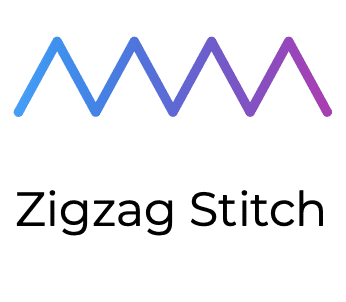When it comes to sewing knit and stretch fabrics, choosing the right stitch is crucial for achieving a professional-looking finished product that stretches with the fabric. For those who do not have access to a serger, or for those who simply don’t want to rethread or take out their serger, one popular stitch for these types of fabrics is the zig zag stitch.
For woven fabrics, the zig zag stitch is commonly used to finish raw edges and prevent fraying. When using the zig zag stitch for woven fabrics, set the stitch width to 2-3mm and the stitch length to 2-3mm. The average length of a zig zag stitch is around 2-3mm or 0.08-0.12 inches. Sew along the edge of the fabric with a narrow zig zag stitch, making sure the stitches catch both layers of the fabric. Trim off any excess fabric close to the stitches to create a neat finish.
The zig zag stitch is a versatile stitch that can be used for a variety of purposes, including finishing raw edges, sewing seams, and attaching elastic. This stitch creates a zig zag pattern by alternating between a straight stitch and a diagonal stitch, allowing the fabric to stretch without the stitches breaking.
Here are some tips on how and when to use the zig zag stitch for knit and stretch fabrics:
- Choose the right needle and thread
When sewing knit and stretch fabrics, it’s important to use the right needle and thread to prevent the fabric from stretching out of shape or causing the thread to break. For knit fabrics, use a ballpoint needle, which has a rounded tip that glides between the fibers instead of piercing them. Use a polyester or nylon thread that has some stretch to it to prevent it from breaking under the tension of the fabric.
- Set the stitch length and width
The length and width of the zig zag stitch can vary depending on the fabric and the purpose of the stitch. As a general rule, use a shorter stitch length for lighter weight fabrics and a longer stitch length for heavier fabrics. For a standard zig zag stitch, set the stitch width to 2-3mm and the stitch length to 2-3mm.
- Use the zig zag stitch to finish raw edges
When working with knit and stretch fabrics, the edges can easily fray or curl up. To prevent this, use the zig zag stitch to finish the raw edges. Sew along the edge of the fabric with a narrow zig zag stitch, making sure the stitches catch both layers of the fabric. Trim off any excess fabric close to the stitches to create a neat finish.
- Use the zig zag stitch to sew seams
When sewing seams on knit and stretch fabrics, use the zig zag stitch to allow the fabric to stretch without breaking the stitches. Align the edges of the fabric with right sides together and sew a straight stitch along the seam line, then go back over the seam with a zig zag stitch. This will reinforce the seam and allow it to stretch with the fabric.
- Use the zig zag stitch to attach elastic
When attaching elastic to knit and stretch fabrics, use the zig zag stitch to allow the elastic to stretch with the fabric. Align the edge of the elastic with the edge of the fabric and sew a straight stitch along the edge, then go back over the seam with a zig zag stitch. This will secure the elastic in place and prevent it from slipping or rolling.
Zig Zag for Stretch Fabrics
Stretch fabrics are popular in clothing construction because they provide comfort and allow for movement. However, some types of stretch fabrics can be difficult to work with and may require special attention when it comes to stitching. Here are some types of stretch fabrics that may require a zig zag stitch to stop the stretch of the fabric:
- Spandex: This is a highly elastic fabric that is commonly used in activewear, swimwear, and dancewear. Spandex can be tricky to sew, and a straight stitch can cause the fabric to pucker or stretch out of shape. A zig zag stitch is recommended to prevent this.
- Jersey: Jersey is a soft, stretchy knit fabric that is commonly used for t-shirts, dresses, and skirts. While jersey can be sewn with a straight stitch, a zig zag stitch can help to prevent the fabric from stretching out of shape over time.
- Knit fabrics: This category includes a variety of stretchy fabrics such as cotton knit, polyester knit, and rayon knit. These fabrics are commonly used for t-shirts, dresses, and other garments that require stretch. A zig zag stitch is recommended to prevent the fabric from stretching out of shape during wear.
- Lycra: is commonly used in activewear, swimwear, and dancewear. Like spandex, Lycra can be tricky to sew, and a zig zag stitch is recommended to prevent the fabric from stretching out of shape.
- Stretch Wovens: This is a type of fabric (like stretch denim) that has been woven with spandex or other stretch fibers. While denim can be sewn with a straight stitch, a zig zag stitch is recommended to prevent the fabric from stretching out of shape over time.
In conclusion, the zig zag stitch is a versatile stitch that can be used for both woven and stretch fabrics. By choosing the right needle and thread, setting the stitch length and width, and using the stitch correctly, you can achieve a high-quality finished product that stretches with the fabric while preventing fraying on woven fabrics.
Welcome to TheSewingBuzz.com, your ultimate destination for all things sewing! I'm Margie Vaudreuil, the creative force behind TheSewingBuzz and SewingPatternSecrets.com. As a lifelong New Englander from suburban Boston, my passion for the creative arts spans fine art, design, fiber arts, and digital design. My sewing journey has been profoundly influenced by my mother, who crafted my costumes and clothing in the 60s and 70s, and my fraternal grandmother, who, despite leaving school in 6th grade to work as a seamstress, designed many of her children's clothes with incredible skill and creativity. Guided by my strong Christian faith and supported by my loving family, I draw inspiration from every aspect of my life. My husband, Mark, is my best friend and a sales guru, and my son, Alex, resides in San Jose, California. I am also a proud step-grandmother to Hazel and Gottlieb, and stepmother to Sean and his lovely wife, Lisa, who live in Austria. As the founder, developer, web designer, content creator, and design manager of TheSewingBuzz, my mission is to inspire and empower sewists of all levels. Here, you'll find a wealth of sewing patterns, tips, and tutorials designed to help you create beautiful, unique garments and accessories. Join me on this exciting sewing adventure and let's bring your creative visions to life! "Make it your goal to live a quiet life, minding your own business and working with your hands, just as we instructed you." 1 Thessalonians 4:11 Visit us at: TheSewingBuzz.com SewingPatternSecrets.com MarjorieVaudreuilDesigns.com
Recent Posts
Women's Genevieve Blouse: V or U Shaped Neck, Short Sleeve or No Sleeves
Women's Genevieve Blouse We love the simplicity of this pattern, making it a great first woven blouse.Tips for Beginners:Try the round neck version; the V neck requires special care.Avoid...
Toddler Bib Sewing Pattern for Beginners: Catch All the Crumbs
Catch-All Toddler Bib Pattern This Toddler Bib is an easy sewing pattern for baby shower or gift. Sew this pattern as part of a Grow-A-Long bib series, with the Baby Sized Angel’s Wings...


2 thoughts on “The Versatile Zig Zag Stitch: How to Use it for Woven and Stretch Fabrics”